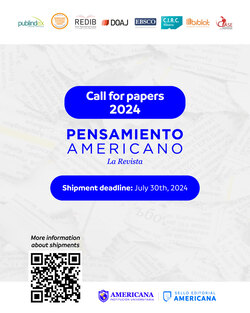Development of numerical thinking through didactic sequence in educational escuela nueva for second grade
DOI:
https://doi.org/10.21803/penamer.14.28.377Keywords:
Didactic sequence, New School, Numerical thinkingAbstract
Introduction: The article aims to demonstrate the use of a didactic sequence in the Escuela Nueva model, which due to its integrating characteristics must be present at various times in the process of developing numerical thinking. Objective: To analyze the effects evidenced by the implementation of the didactic sequence in the Escuela Nueva model, in the development of numerical thinking in second grade students. Methodology: Mixed research, in the line of research: development of mathematical thinking. It was carried out with students from the second grade of primary school, between 7 and 9 years old, from the Guavio de Fusagasugá Municipal Educational Institution. Results: To achieve this goal, a pedagogical proposal was designed and applied, which consisted of a didactic sequence that contains three sessions, where cooperative work is used, the game as a motivating agent, the use of didactic material that in turn is conducive to the students activities such as counting, numbering, relating, comparing, performing mental calculations as well as the use of addition and subtraction operations, which offered opportunities to enhance students' numerical thinking. Conclusions: Continuous and effective commitment
was demonstrated, which allows to initiate a process of methodological and didactic change in the teaching and learning process in the area of mathematics, taking advantage of and adapting all the resources of the institution and the community, such as: physical spaces, didactic material and development of a playful pedagogy that allowed the interaction of students and teachers for the development of numerical thinking, demonstrating that through a didactic sequence, students build knowledge, make numerical relationships and learn significantly.
Downloads
References
Abela, J. (2002). Las técnicas de análisis de contenido: una revisión actualizada. Fundación Centro de Estudios Andaluces.
http://public.centrodeestudiosandaluces.es/pdfs/S200103.pdf
Berelson, B. (1952). Content analysis in communication research. Free Press, Glencoe. https://psycnet.apa.org/record/1953-07730-000
Cantoral, R., Montiel, G. & Reyes-Gasperini, D. (2015). Análisis del discurso Matemático Escolar en los libros de texto, una mirada desde la Teoría Socioepestemológica. Avances de Investigación en Educación Matemática, 8, 9 – 28. https://doi.org/10.35763/aiem.v1i8.123
Chevallard, Y., & Johsua, M. (1982). Un exemple d’analyse de la transposition didactique: la notion de distance. Recherches En Didactique Des Mathématiques Grenoble, 3(2), 159–239. https://publimath.univ-irem.fr/biblio/AAR99089.htm
Emmanuele, D., González, M. I., Introcaso, B. & Braccialarghe, D. (2010). Análisis de libros de cálculo en carreras de ingeniería: Su relación con los cambios sociopolíticos en Argentina. Educación matemática, 22(2), 35-63. http://www.scielo.org.mx/scielo.php?script=sci_arttext&pid=S1665-58262010000200003
Espinoza, R. F., Pochulu, M. D. & Jorge, M. J. (2013). El análisis didáctico de textos escolares ¿qué herramientas proveen las diferentes líneas y enfoques en Educación Matemática? http://funes.uniandes.edu.co/18967/
Etchegaray, S. (2001). Análisis de significado personales e institucionales: El problema de su compatibilización. En M. F. Moreno, F. Gil, M. Socas y J. Godino, (Eds.), Quinto Simposio de la Sociedad Española de Investigación en Educación Matemática (pp. 159–168). Almería: Servicio de Publicaciones. https://www.seiem.es/pub/actas/index.shtml
García, G. (1996). Reformas en la enseñanza de las matemáticas escolares: perspectivas para su desarrollo. Revista EMA, 1(3), 195–206. http://funes.uniandes.edu.co/1025/
Godino, J., Wilhelmi, M. & Font, V. (2006). Análisis ontosemiótico de una lección sobre la suma y la resta. RELIME. Revista latinoamericana de investigación en matemática educativa, 9(1), 131-156. http://relime.org/index.php/Howson, G. (1995). TIMSS monograph No. 3: Mathematics textbooks: A comparative study of grade 8 texts. Pacific Educational Press.
Love, E., & Pimm, D. (1996). “This is so”: A text on texts. En A. J. Bishop, K. Clements, C. Keitel, J. Kilpatrick, & C. Laborde (Eds.), International handbook of mathematics education (pp. 371-410). Dordrecht, The Netherlands: Kluwer Academic Publishers.
Otte, M. (1997). What is a text? En Christiansen, B., How-son, A.G., Otte, M. (eds). Perspectives on mathematics education, (pp. 173-203). Springer, Dordrecht: D. Reidel Publishing Company. https://doi.org/10.1007/978-94-009-4504-3
Pimm, D. (1987). Speaking mathematically. Nueva York: Routledge y Kegan Paul. Trad. cast. (1990). El lenguaje matemático en el aula. Ministerio de Educación y Ciencia - Ediciones Morata.
Pimm, D., & Keynes, M. (1994). Mathematics classroom language: Form, function and force. In R. Biehler, R. Scholz, R. Sträßer, & B. Winkelmann (Eds.), Didactics of Mathematics as a Scientific Discipline (pp. 159–169). Kluwer Academic Publishers. https://www.researchgate.net/
Radford, L. (1997). On psychology, historical epistemology, and the teaching of mathematics: Towards a socio-cultural history of mathematics. For the Learning of Mathematics 17(1), 26-33. http://www.jstor.org/stable/40248219
Rodríguez, F. M., Basso, A. & Garcia Gonzalez, M. D. S. (2019). El análisis de textos como metodología de investigación en educación matemática. http://ri.uagro.mx/handle/uagro/2703
Schubring, G. (1987). On the methodology of analysing historical textbooks: Lacroix as textbook author. For the learning of mathematics, 7(3), 41-51. https://flm-journal.org/
Van Dormolen, J. (1986). Textual analysis. In Christiansen B., Howson A.G., Otte M. (eds) Perspectives on mathematics education (pp. 141-171). https://doi.org/10.1007/978-94-009-4504-3_4
Downloads
Published
Versions
- 2021-12-30 (5)
- 2024-05-31 (4)
- 2021-12-31 (3)
Issue
Section
License
Copyright (c) 2021 Pensamiento Americano

This work is licensed under a Creative Commons Attribution-NonCommercial-NoDerivatives 4.0 International License.
The author or authors of an article accepted for publication in the Journal Pensamiento Americano will transfer all of the patrimonial rights to the American University Corporation free of charge, within which are included: the right to edit, publish, reproduce and distribute both print media as digital, in addition to include in article in international indexes and / or databases, likewise, the Editorial Seal is authorized to use the images, tables and / or any graphic material presented in the article for the design of covers or posters from the same magazine. By assuming the patrimonial rights of the article, it may not be partially or totally reproduced in any printed or digital media without its express permission.
AUTHORITY ASPECTS
For the Pensamiento Americano Journal, all the authors of an article have made substantial contributions to the research and the manuscript, and they share the responsibility when the article presents errors, fraud in some way or violations of copyright.
After submitting an article, the journal does not accept the addition, deletion or change in the order of the authors, in addition we reserve the right to release the article when it has been submitted to the journal and under no circumstances will American Thought accept the article. withdrawal of an article during any phase of the editorial process






